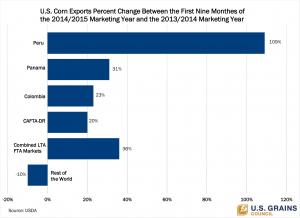This week’s U.S. Grains Council’s (USGC’s) Chart of Note illustrates the importance of trade liberalization, demonstrating that U.S. corn exports to four Latin American markets with recent free trade agreements (FTAs) have vastly outperformed U.S. corn exports to the rest of the world.
During the first nine months of the 2014/2015 marketing year, which began Sept. 1, 2014, U.S. corn exports to the world totaled 34.2 million metric tons (1.3 billion bushels), down 2 percent from the same period a year ago. However, exports to Latin American countries with FTAs are not following this trend.
Examples of this include:
- exports to Colombia, the third largest market for U.S. corn this year, are up 23 percent;
- exports to the CAFTA-DR countries including five Central American countries and the Dominican Republic that combined are the fifth largest market for U.S. corn, are up 20 percent;
- Peru, the sixth largest market for U.S. corn, is up 109 percent; and
- Panama, the 12th largest market for U.S. corn, is up 31 percent.
These markets all benefit from comprehensive trade agreements with the United States that create mutually beneficial trade partnerships and ultimately increase opportunities for U.S. coarse grains and co-products.
But the job of removing barriers to global grain trade isn’t done yet, as U.S. corn exports to other parts of the world are currently down 10 percent.
Right now, there are key multilateral trade agreements being negotiated, the Trans-Pacific Partnership (TPP) and Trans-Atlantic Trade and Investment Partnership (T-TIP). These trade agreements are expected to provide similar improvements in market access to U.S. farmers as the FTAs in Latin America but on a larger scale that would ease barriers to free trade across Asia and Europe.


